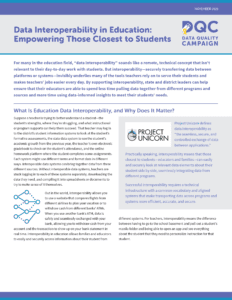For many in the education field, “data interoperability” sounds like a remote, technical concept that isn’t relevant to their day-to-day work with students. But interoperability—securely transferring data between platforms or systems—invisibly underlies many of the tools teachers rely on to serve their students and makes teachers’ jobs easier every day. By supporting interoperability, state and district leaders can help ensure that their educators are able to spend less time pulling data together from different programs and sources and more time using data-informed insights to meet their students’ needs. This brief discusses why interoperability matters and examples of how it’s making a difference.
isn’t relevant to their day-to-day work with students. But interoperability—securely transferring data between platforms or systems—invisibly underlies many of the tools teachers rely on to serve their students and makes teachers’ jobs easier every day. By supporting interoperability, state and district leaders can help ensure that their educators are able to spend less time pulling data together from different programs and sources and more time using data-informed insights to meet their students’ needs. This brief discusses why interoperability matters and examples of how it’s making a difference.
Access, Governance, Transparency


